There are many examples of too little, too late in the automotive world. The 2008-2009 Pontiac G8 is perhaps the only example of more-than-enough . . . when it no-longer-mattered.
Pontiac was practically on the embalmer’s table when it twtiched for a moment, just before the fluid began to flow.
That twitch on the table was the G8 – a nondescript name for a car worthy of the Pontiac brand as it had once been. Because it was at least three things nothing commonly sold by Pontiac in decades had been: Full-size, rear-wheel-drive and V8 powered.
The last time Pontiac had offered a remotely similar car in its lineup was back in 1981, when the last of the real (rear-drive) Bonnevilles – a not-nondescript name- left the factory.
It did have a V8, but just barely.
One of the very last V8s made by Pontiac, the sad 301 – which was euthanized by GM before Pontiac engineers could develop it into something worthy.
They were never given the chance.
Pontiac’s V8 was terminated that year.
After ’81 Pontiac stopped offering much that was even Pontiac, except in name. What had been GM’s Excitement Division had been transformed into a marketing division.
It sold re-branded Chevys; recycled Buicks and Oldsmobiles in mufti.
There had always been a degree of cross-pollination among the various GM divisions but for most of GM’s history as a car conglomerate, each of its divisions had their own engineering divisions. Basic structures may have been shared between the brands – for example, the A body chassis – the underlying frame – was used to build the Pontiac Tempest/GTO of the ‘60s and the Chevy Chevelle/Olds Cutlass of the same era (1960s).
But a Pontiac Tempest/GTO had a Pontiac engine, as well as Pontiac-specific sheetmetal, interior and trim.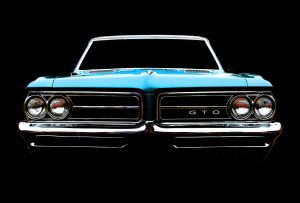
After 1981, “Pontiacs” had the trim.
The engines were gone. At least, the Pontiac V8 was gone. After ’81, all Pontiacs that still had V8s had Chevy V8s and were thus fundamentally identical to the Chevys they shared their frames with. This homogenization would doom what had been one of GM’s best-selling brands.
Oldsmobile, too.
Matters were made worse when GM began to transition from making rear-wheel-drive cars to front-wheel-drive cars, as well as downsizing the cars themselves. Pontiac (and Oldsmobile and Buick, too) lost most of what had been their strongest selling points, which were that they differed fundamentally from the FWD/downsized cars from Japan they now competed with directly.
Previously, American cars were the alternative. They were for people who didn’t want a downsized/FWD/four cylinder car from Japan.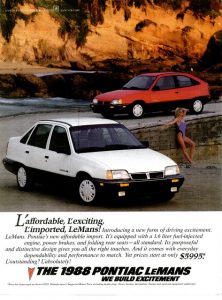
Now there the same kinds of cars as offered by the Japanese . . . just not as well-built.
GM’s market share transitioned along with the changeover.
It was hard to convince people who bought Pontiacs in the past because they were Pontiacs to buy cars that fundamentally weren’t anymore.
The badge-engineered arrowhead twisted in the wind.
To be fair to GM, the transitioning was unnatural. It was forced on the entire American car industry by the government, which decreed “corporate average” fuel efficiency standards which the traditional V8-powered/rear-wheel-drive and large-sized Americans cars of the past simply couldn’t meet. They were de facto outlawed without actually outlawing them directly.
It was still legal for car companies to build and try to sell large, V8-powered rear-drive cars. But they were very hard for other than rich people to buy, because of the “gas guzzler” penalties which the car companies were forced to fold into the sticker price of such cars.
This is how and why – traditional American cars were obsolesced as mass-produced cars
Miraculously, Pontiac survived the loss of its not-Chevy/isn’t-Buick V8 and the general trend toward American-made Japanese-style cars. The strength of Pontiac’s past carried it surprisingly far into the future.
But by the early 2000s, even those fumes had largely dissipated.
An attempt was made in 2004 to jump-start the excitement by bringing back a great name from Pontiac’s past – the GTO. And it wasn’t a bad car. But it was a bland car – something the original GTO never was.
It looked like a Lumina coupe with a hood scoop – and as such blended in with traffic, which was actually a good thing if you wanted to make use of the car’s 350-400 horsepower V8 – which was far more powerful than almost any classic-era GTO’s V8.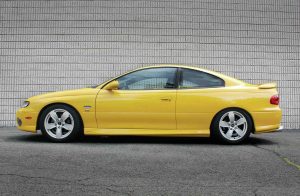
But the visuals were as much what made a GTO as what was under its hood – and while power was never an issue with the car, personality was. Motor Trend – intending a compliment – got it right when it wrote that the GTO’s “bodywork is as clean and sleek as a modern Euro coupe’s.”
Precisely the problem. Applied to anything with a GTO badge on its flanks, this is insulting.
A GTO should turn heads as quickly as it runs the quarter mile. This one didn’t.
Price was a problem, too.
The original ’64 GTO succeeded because it made high-performance economically accessible. It was specifically meant to be a young man’s car – and so offered with the things young men tend to like in their cars, such as a powerful engine and lots of attitude – but without the things only older men can usually afford, such as air conditioning and leather seats.
The new GTO came standard with climate control AC and a long list of luxury amenities, including a 200 watt, 10-speaker Blaupunkt audio system – which accounted for its $33,695 base price.
In 2004.
Which is the equivalent, in 2019 fed funny money, of $45,343.
Not many young men could afford the GTO – and the older men who could mostly bought Corvettes instead. The GTO was cancelled after two years of availability, in 2006.
A Holden (GM’s Aussie brand) Commodore was suited up in Pontiac attire and sent into the breach – not unlike Wenck’s 12th Army, ordered by the fuhrer from the bowels of his bunker to turn about and hurl the Russians out of besieged Berlin. The Russians outnumbered the Germans by 10 to 1 and had things like ammunition, tanks and fuel – all of which the Germans lacked.
Wenck’s task was hopeless – and he had the smarts to not even try.
The G8’s task probably was, too – but Pontiac deserves credit for at least trying. And for going out not just standing tall but going sideways.
The G8 packed as much as 415 horsepower from its available 6.2 liter V8 – the largest V8 GM had put in any car in decades. And it was available with a six-speed manual transmission – something as rare to find in a four-door anything circa 2008 as snowmen in the Sahara.
But while there was nothing wrong with the G8 – and lot very much right with it – it was the wrong car for what Pontiac had become by the time it appeared in 2008. Decades had slipped by since Pontiac was last associated with performance.
Offering up a car like the G8 under the Pontiac label in ’08 was like Lexus deciding to launch a diesel pick-up truck with a three-on-the-tree and uncarpeted metal floorpans.
The meaning of the badge had changed; actually, it had become meaningless.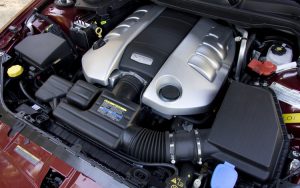
Pontiac by this time was just another anodyne marketing platform for unexciting cars. The division that had made so much hay – and so much money – selling Carousel Red GTO Judges in the ‘60s and black and gold Trans-Ams by the hundreds of thousands in the ’70s was just a shell of itself by the 2000s. The people who had bought Trans-Ams back in the day – and real GTOs in the days before – were now too old for performance cars and the people in the market for performance sedans thought BMW, Infiniti and Lexus.
Tragically, the G8 – unlike the briefly revived GTO – was affordable.
A G8 GT – which came with a 361 hp, 6.0 liter V8 – stickered for just shy (by $5) of $30,000 – by far the least expensive car you could buy in ’08 with the G8 GT’s bona fides. And the GXP – with the 6.2 liter V8, 415 hp and the ability to rip to 60 in 4.7 seconds – only cost $10k more ($40,000) which was easily $20k less than a comparable M-tuned BMW performance sedan.
By any performance metric, it was an exceptional car.
But it was a car with terrible timing.
Pontiac brought the G8 to market months before the entire car industry practically capsized. GM actually did capsize, of course – and became a subsidiary of Washington, aka Government Motors.
During the reconstruction of GM, it was decided there was no future for Pontiac – or Oldsmobile or Saturn and Hummer, which all got read into the history books.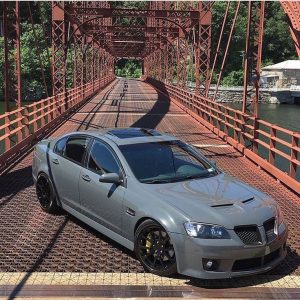
But while the G8 couldn’t save Pontiac, it did rehab its image. The very last new Pontiac was the most powerful, quickest, fastest and best-handling car Pontiac ever offered for sale. It hardly mattered that only a handful actually did sell (just 1,829 GXPs). The point had been made.
It’s just a shame it was made too late.
Pontiac G8 Trivia:
- The base G8 didn’t come with a V8. Instead, standard equipment was GM’s 3.6 liter V6, which by ’08 had become the latter-day equivalent of the ’70s-era small-block V8 that GM offered in almost every car it made.
- Though considered a full-size car at the time, the G8 – which was 196.1 inches long overall – would be considered a mid-sized car by modern standards – very much in keeping with the original 1964 GTO – which was based on the mid-sized Tempest.
- The G8 GXP was the last new GM to be equipped with “skip shift” – an early fuel-saving gadget that nudged the six-speed manual transmission from first to fourth – instead of first to second – unless the driver had floored the gas pedal. Which most drivers did, to avoid skipping the shift – at the cost of using even more gas!
- GXPs also came with high-capacity Brembo brakes and standard FE3 suspension, which GM said had been tuned on the famous Nurburgring in Germany. GXPs also got more aggressive 40-Series Bridgestone Potenza tires and different from and rear clips.
- The GXP actually survived Pontiac – re-appearing in 2014 in Chevy livery. It was now called the SS but it was basically the same car. GM offered it for three years – through the 2017 model year – which meant that the Chevy outlasted the Pontiac by one full year.
Excerpted from the forthcoming (eventually) book, Doomed.
…
Got a question about cars – or anything else? Click on the “ask Eric” link and send ’em in!
If you like what you’ve found here please consider supporting EPautos.
We depend on you to keep the wheels turning!
Our donate button is here.
If you prefer not to use PayPal, our mailing address is:
EPautos
721 Hummingbird Lane SE
Copper Hill, VA 24079
PS: Get an EPautos magnet (pictured below) in return for a $20 or more one-time donation or a $10 or more monthly recurring donation. (Please be sure to tell us you want a sticker – and also, provide an address, so we know where to mail the thing!)
My latest eBook is also available for your favorite price – free! Click here. 


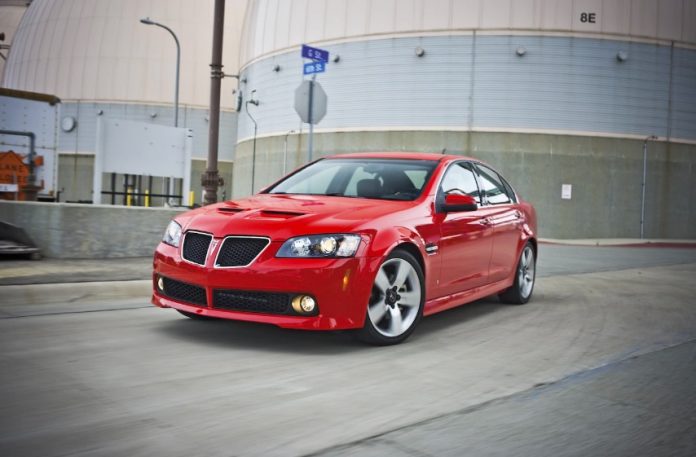











I owned a 1962 Pontiac Catalina convertible for a while with a 389 tri-pack. black with a red interior. really neat car. A real beauty.
Hi Mark,
Gorgeous car! A Pontiac with three carbs… lawswee!
yeah it was neat. made some great sound. it was 1963 actually.
the tri-pack convertible combo was very rare. I think they built like 5 of them. This is very close to how it looked: https://www.motorious.com/vehicles/178876/1963-pontiac-catalina-convertible
The Pontiacs I remember (my GRAND-Parents, on my “Mudder’s” side, had a ’65 Catalina and a ’71 Grand Prix, which I got when I graduated from college in ’84 and drove all the way across country to “Knife and Fork” school in RI) had ATTITUDE. A quality no longer appreciated in today’s pussy-whipped “Amerika”.
Hi Doug,
I’ve loved ’60s-era Wide-Track Pontiacs since I was a kid. They are among the most beautifully styled cars ever produced, in my estimation. Grand Prix, Catalina 2-plus-2, Bonneville . . . also such great names!
Nothing like them anymore.
Eric – you’re probably confusing General der Panzertruppen Walther Wench OB, 12 Armee, with SS-Obergruppenfuhrer Felix Steiner. Steiner, in charge of a Kampfgruppe, had about 30,000 men and 50 or so running tanks, and was expected to throw back Marshal Zhukov’s First Belorussian Front from encircling Berlin. Steiner was outnumbered by at least 25-1, and had practically no air support. When ordered to attack, for all practical purposes, he disobeyed. This is shown in the 2004 movie “Downfall”, where Hitler flies into a rage upon learning that Steiner’s expected counter-attack never took place.
https://www.youtube.com/watch?v=xBWmkwaTQ0k
Wenck DID disengage from Gen. “Bil Bill” Simpsons Ninth Army, which had bridgeheads over the Elbe and had taken Magdeburg, and was pushing the 12th “Army” (about actually at Corps strength, and low on tanks, artillery, and supplies) out of the Harz mountains. In reality, a sort of de facto truce was in effect, with the Americans encouraging Germans to surrender. Wenck did reach the outskirts of Berlin, but only to hold open a corridor for civilians and hospitalized soldiers to be evacuated and taken to the Americans, waiting about 70 miles away. Wenck himself was the last man over the last bridge on the Spree river that was blown up with the Soviets approaching.
Dear Leader Obama seized General Motors as payback for supporting opponents in 2008, and under Pelosi’s 35 MPG standard the auto industry collapsed to just sub-2000cc turbo 4’s. Social engineering.
GM’s plan was to use the Commodore chassis as the source of the Camaro and Impala, and almost certainly the G8 would move to the Canadian plant of both, as the Commodore would set the basis for all three in Oshawa.
Why elections matter, and why big city liberals create the worst problems. The car of Peter Brock was doomed by socialists who seize opponents.
Hi Bobby,
Yup. Almost every car I’ve test driven/reviewed during the past two years is powered by a 2.0 liter turbo four… the affirmative action CAFE Compliance engine!
We got many variants of the VE-VF Commodore here in Australia, Jack’s pick is the 6.0L VF Calais wagon. And yes, lots of utes too; the SS ute being the young tradesman’s wheels of choice before this dual-cab blight.
Like the excerpt from the book says,
“Matters were made worse when GM began to transition from making rear-wheel-drive cars to front-wheel-drive cars, as well as downsizing the cars themselves. Pontiac (and Oldsmobile and Buick, too) lost most of what had been their strongest selling points, which were that they differed fundamentally from the FWD/downsized cars from Japan they now competed with directly.
Previously, American cars were the alternative. They were for people who didn’t want a downsized/FWD/four cylinder car from Japan.
Now there the same kinds of cars as offered by the Japanese . . . just not as well-built.”
I will never understand why you guys did this, you took your Unique Selling Point and threw it away. You guys always had the most ostentatious RWD big block muscle, the layout has survived longest and been most successful in your pick ups. (I do like the new Expedition and Lincoln Aviator, you are becoming great again with a hint of your 1960’s chrome and styling – pity we can’t get them here).
Meanwhile, in Australia:
The rivalry was always Holden-Ford, but the 70’s fuel crisis hit here, too. Chrysler did their biggest Valiant thoughout the 70’s, but it was extinct by 1981. For the 1980s, Ford held their breath, and developed a full size (you guys would say ‘compact’) XD Falcon, focussing on drivetrain efficiency. Holden dropped their legendary HQ-WB Kingswood and Torana platforms, and took the smaller Opel Rekord and ‘Australianised’ it, becoming the VB Commodore, with all Aussie drivetrains, including V8.
Fuel prices eased after Ford dropped their V8 in 1982, but otherwise, their larger Falcon creamed the Commodore and GM-H nearly went bust. Their one saving grace: “V8’s till ’98”. If you wanted a V8 affordable car, Commodore it was. This is important to the GTO/G8/SS, because if they had not done this the export models may not have existed.
Beginning in the 90’s, Aussie V8s began to flower again – XR8s, the SS, the specials by HSV and Tickford, and the boom here went into overdrive in the early 2000’s. The new VE platform was engineered in left hand drive, and I’m glad some made it over to you. It was a car culture of bright colours, big output, V8s and turbo 6’s, a new golden age. The 2010’s saw the biggest, most powerful variants of all, like the W427, SSV Redlines, and XR6 turbo Sprint.
Our mining boom, high floating AUD, union wage rates and incredibly inept, short sighted industrial and trade policy saw our industry close in 2017. If you see any quality low K Aussie muscle of recent years, quietly shed it… and enjoy it in moderation!
The G8 was nice…but I just couldn’t find a reason to select one over a Charger or Magnum. The SS was ridiculous, with a several thousand dollar premium over a Charger.
It’s tragic (for GM) that they never properly marketed any of these Ausie cars they brought here. I have both a 2005 GTO and a 2017 SS. How awesome the GTO was, is what encouraged me to buy the SS.
Of course what was tragic for GM was awesome for me. When I bought each car was at a time that GM decided it was time to liquidate the lineup. Bought the 2005 GTO in June of 2005 for $27K (when the MSRP was just shy of $34K). In 2017 did not even need to haggle on the SS. Chevy just gave a 20% discount to the entire lineup. $50K SS went down to $40K before walking into the dealership. Of course I haggled and was still able to get another $1500 knocked off.
Both are great cars, but, I still like driving the GTO more. Does not have any of the nanny technology the SS has: Parking assist, electronic parking brake, incessant warning chimes for anything other than driving like a great grand mother (but, at least the chimes can be turned off).
and different from and rear clips
Americans cars
I don’t think I’m gonna buy the book. I wouldn’t be able to decode it.
Hey Eric – thanks for rekindling the memories! I’ve seen the G8 just before returning home to Europe.. it is one amazing ride. If I were to return to the US even for a few months, I would buy one and probably end up taking it with me back home.
Hi Euro,
Thanks for the kind words! I was able to drive a new one – a press car – back in the day. My review should be around here somewhere…
Here in MN the G8 is listed lower than the gto and ss.
MN lists cars? What’s MN; a state? What’s a list? A list of prices (for used cars)? I must just be a dummy.
Craigslist in the state of Minnesota.
And I’m pretty sure this car was one of Joe Salerno’s favorites.
I love the G8! I wish I had known about it back in ‘10 when I got a Camaro. I love all of the Holden Commodore derivatives (G8, GTO, SS, and Caprice PPV). I’d own 1 of each if I could.
These cars are holding value fairly well too. The GXP’s, in my opinion, will be worth tons in the future. Ditto the Chevy SS.
Hi Anonymous,
It’s sad that GM did what GM so often does – gave upon the car. As a Chevy, the SS made sense. It fit the brand – but the marketing was nonexistent. Most people didn’t know the car was even in the lineup.
I was holding out for the Caprice PPV version to make it to the chevy dealers for the public. It was a longer wheelbase version of the SS. It was bland, yes, but that’s what I like. If they numbed the suspension tuning down a bit from the SS it easily could have been a Challenger/300 competitor. I think it would have made a great bigger RWD Olds or Buick too dressed up a little nicer inside. But GM had other plans, and why I don’t own any GMs anymore, expect our beater farm truck.
These same cars sold here in Australia cost 2X what the US price was, and sold a lot more. Aussies don’t make good looking 2 door cars. This one is rather bland. But there were even more powerful motors available, right up to 500 newtons. One of these cars took on the best and most expensive European cars and beat all of them on the track in just about every way possible. It’s so sad the Aussie unions sabotaged the car industry here. And our governments didn’t help matters either.
Your right Eric, Pontiac was awesome in the 60’s and 70’s.
My Dad drove 60’s Grand Prixs. I loved those big boats and wish they were still around. He was an on-the-road salesman and told me a salesman had to drive the mid grade cars for sales. I followed suite and my first working car was a 6000 (crap), then 2 Bonnevilles (pretty good except FWD). I, like a lot, then got tired of everything getting smaller and slower and moved to trucks in the 90’s.
My first car was a ’69 GTO Judge, a real one that I bought for $2800 when I was 16. I just wanted to be different than all the others that had SS’s. Unfortunately I totaled a numbers matching future collectible by having to chose between paying the $100 insurance payment that month or get the front tires I desperately needed. I hydroplaned at 35-40mph, hit a pole and she was toast with a severely bent frame. I got $1600 for it and considered myself lucky.
I did like the G8 a lot but never got one. If I remember it was because it was because it was too ‘sporty’ for living on the road. I drove the last year of the SS a few years ago and same thing, suspension was tuned way to sporty for me, although I would have bought it if they would have done some kind of ‘touring’ suspension.
Will we ever get another land yacht, RWD V8 again? My current 300 seems the closest you can get sub-$50K. I do love the 7 series and S series sizes, but even if I could do the $70-100K I could never drive that for work.
I think I read from you a little while back that Lincoln might be flirting with a bigger sedan again??
No Z-Car or 5.0 Mustang owners ever feared a G8 GXP pulling up next to them at a stoplight…..
Because none ever did!
BWAHAHAHAHAHAHAHA!
probably fun to drive I guess but looks like a non-descript blob styling wise. I bet you pick one up for next to nothing.
GXP probably held it’s value as it’s manual with all the extra goodies